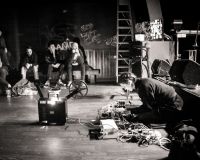Studio blog
Posted on Fri 23 Jan 2015
'It's like a cross between a cinema, a den and a Tardis'...
This week, we have been zipping ourselves into Teleportation Tents and working out how to strike a balance between storytelling and play, we played with prototype robots that had been designed to demystify computing concepts for 13 – 14 year olds, and we were host to a brilliant Urban Interaction…
Testing the Teleportation Tent in the meeting room
Posted by

Jasmine Butt
Jasmine is a musician, synth builder and AV artist who is currently exploring modular synthesis.This week, we have been zipping ourselves into Teleportation Tents and working out how to strike a balance between storytelling and play, we played with prototype robots that had been designed to demystify computing concepts for 13 – 14 year olds, and we were host to a brilliant Urban Interaction Design workshop, facilitated by the DCRC.
Yesterday afternoon, Mandy Rose and Amy and May of Anagram turned out the lights in the Meeting room and put up a Teleportation Tent to get stuck into some testing for their REACT Play Sandbox project. While inside, the walls of the tent will become a 360 degree cinema screen. Using different objects with their own RFID tags, children will be able to choose different characters, objects and environments, (e.g. panda, trumpet, Mars) to change the narrative playing out around them. Yesterday’s tests were an investigation into how quickly the kids wanted to change the narrative and their environment. Amy and May want to create a story structure that will adapt to the right pace and keep the kids engaged. The task of balancing this kind interaction and narrative is a relatively new and tricky one. Amy has just written a brilliant blog exploring how to get kids to swim in a ‘sea of association’ and encourage them to create their own play, rather than doing all the work for them. Mandy Rose has also written a great blog about journeys, questions and emerging hybrid forms of interaction and narrative.
Today and tomorrow, the DCRC are hosting an Urban Interaction Design workshop in the Studio, inviting designers and researchers from multiple disciplines to explore new ways to conceptualise and design ‘smart objects’ and develop a greater understanding of tangible computing and situated technologies. They will be involved in a number of workshops, talks and exercises exploring architectural space, multi-sensing, making and systems. We will have some more concrete outcomes to write about next week.
In other DCRC news, Research Fellow Esther MacCallum-Stewart has just released a book on love and games. Co-written with Professor of Cultural Studies at Sweden’s Lund University, Jessica Evenold, Game Love: Essays on Play and Affection explores new narratives found in gameplay, which seek to engage with love in a variety of ways.
There is currently an opportunity to join the DCRC, as part of UWE’s 3D3 doctoral studentship competition. The studentship will involve practice-led research in digital arts, design, culture and media in one of four research units; The Centre for Fine Print Research (CFPR), The Digital Cultures Research Centre (DCRC), the Centre for Moving Image Research (CMIR) or the Bristol Cultural Research Group (BCRG). Find out more about this exciting opportunity here.
Yesterday, a group of Bristol University MSc Students brought their prototype games into the Studio for a user testing session with the residents. They have been building games and robots that are designed to demystify computing concepts for 13-14 year olds.
Speaking of code-teaching robots, a brilliant Guardian article has just been written about resident Silas Adekunle, and his company Reach Robotics. The article introduces Brute and Berserker, Reach Robotics’ battling quadruped Mecha Monsters. In this article, Silas also touches on why the robotics industry is becoming less risky for hardware entrepreneurs.
Residents Bristol Braille recently went to the National Council for the Blind of Ireland in Dublin to present a prototype of their new refreshable Braille e-reader, Canute. The device met a really positive response. They will be launching a Kickstarter campaign for their haptic Braille glove reader, Midas in the next couple of months.